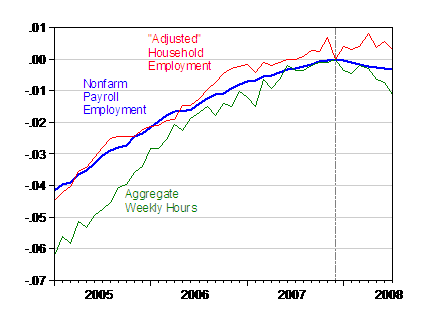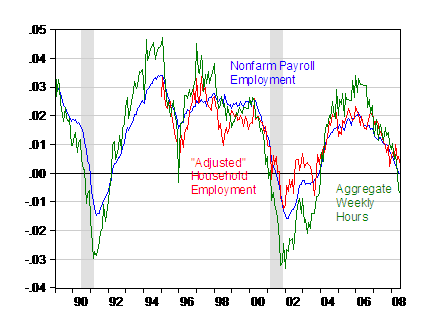Over the past few months, I’ve heard that, while job creation is insufficient to keep unemployment rates constant, job losses have not been consistent with recession. More recently, we’ve heard a slight modification on this “talking point”. Commenting on the August 1 labor market release, WSJ RealTime Economics notes:
So far this year, the economy has shed nearly half a million jobs — hardly a sign of strength.
But it could have been much worse. In testimony before a congressional panel Friday, Bureau of Labor Statistics Commissioner Keith Hall noted that the last two recessions had resulted in 1.5 million lost jobs. “Economic growth is not strong enough to support job growth,” he told legislators, but he added that relative to the last set of official recessions, job losses this time around “have not been as severe.”
In Figure 1, I plot nonfarm payroll employment, the civilian employment series from the household survey adjusted to conform to the NFP concept, and aggregate weekly hours for private industries.

Figure 1: Log nonfarm payroll employment (blue), civilian employment adjusted to conform to the NFP concept (red), and aggregate weekly hours in private industry (green), normalized to zero in 2007M12, all seasonally adjusted. Source: BLS via FRED II, BLS, and author’s calculations.
What is clear is that while the employment series might not be evidencing a severe dropoff, the hours series is [Update: this point has been made previously by Spencer at AB]. This is relevant because growth in hours is at levels consistent with at least the last two recessions. Actually, the hours growth rate is now negative.

Figure 2: 12 month change in nonfarm payroll employment (blue), civilian employment adjusted to conform to the NFP concept (red), and aggregate weekly hours in private industry (green), calculated as 12 month difference in log levels. NBER defined recessions shaded gray. Source: BLS via FRED II, BLS, NBER, and author’s calculations.
Aggregate weekly hours have been experiencing continuous negative growth on a month-to-month basis since January 2008…
Technorati Tags: nonfarm payroll employment,
household employment, recession,
aggregate weekly hours, job losses.
Since this most recent economic recovery is one of the weakest on record, it somewhat stands to reason that employment levels are not dropping in the same proportions as past recessions.
Employer’s were already ‘running lean’. So the reduction in hours is a far more significant indicator of the state of the workforce.
That said, over the past thirty years there has been a big reduction is cumulative payrolls, most recently a large number of well-compensated UAW workers accepted ‘buyouts’ and it was recently reported that Wall Street ‘analyst’ jobs are being off-shored to India. This money that is leaving the US economy.
I’m willing to bet no one has been tracking this number…although it does ‘show up’ in the share of US income reaped by the upper income earners.
So, is there a way to determine (with a fair degree of accuracy) how much ‘inflation adjusted’ payroll has left the US economy?
We’re literally talking tens of millions of well-compensated jobs here.
http://www.bls.gov/news.release/mmls.nr0.htm
The B.L.S. yesterday stated:
“Year-to-date layoff figures in 2008 were the highest January-July totals since 2003”
ANOTHER DIFFERENT LOOK AT THE LABOR MARKET
It is great to finally have someone else looking at the hours worked data. I generally report on it after the employment report at Angry Bear and I find it hard to believe that almost everyone ignores this very important indicator.
Gegner: I suspect you are right that the “lean” labor forces are linked to the relatively small decline in employment numbers, given these macro conditions. Another way to look at this is given the high fixed cost with hiring a given worker (benefits, etc.), it makes sense to adjust on the margin of hours more.
On your more general question of counting hours of those jobs that have been offshored, I wouldn’t have a good idea how to proceed, I’m afraid.
Spencer: Thanks, good point — I’ve added attribution in the text.
I’ve also heard that the number of under-employed — those with part-time jobs who want full-time, but can’t find it — has been increasing faster than the unemployment rate. I don’t have a source handy, but it fits with the declining hours worked.
I suspect that many companies have become more flexible/sophisticated, using temps, per diem positions, subcontractors and consultants, rather than creating contracted 40-hour positions.
Menzie,
That same hours-worked decline is also responsible for sustained productivity growth.
The (potential) implication is that the hours worked drop is concentrated in unproductive areas of the labor force. Could it be service-sector jobs tied to housing? The obvious place to look is retail and restaurant establishments, financial services, housing services, and other services jobs whose demand is somehow tied to the housing market.
If these jobs are less productive, then why did their growth in the 00’s not also depress productivity growth?
I don’t have the answer, but it does seem logical that the “fat” in the economy rests in the service sector, and that service sector unemployment in this cycle could be less correlated to manufacturing unemployment than at any previous cycle in our history. The non-manufacturing ISM has already diverged somewhat from its historical correlation with its manufacturing counterpart.
If the U.S. has a services-led recession, then many of the historical correlations that economists use to gauge the magnitude and length of the downturn will result in inaccurate forecasts.
Very good comments Pearson.
I suggest one of the things we need to focus on is productivity growth that is remaining unusually strong for this point in the cycle.
“Since this most recent economic recovery is one of the weakest on record, it somewhat stands to reason that employment levels are not dropping in the same proportions as past recessions.”
Gegner, you are correct. IBM and HP fired at least 50,000 each in the last recession, to name two, and they hired Indians, not US workers. Many of those fired never found much of another job other that “contracting”, whatever that means. So it stands to reason they do not have 50,000 to add to the unemployment roles this time around and contractors are not eligible for unemployment since they are self employed.